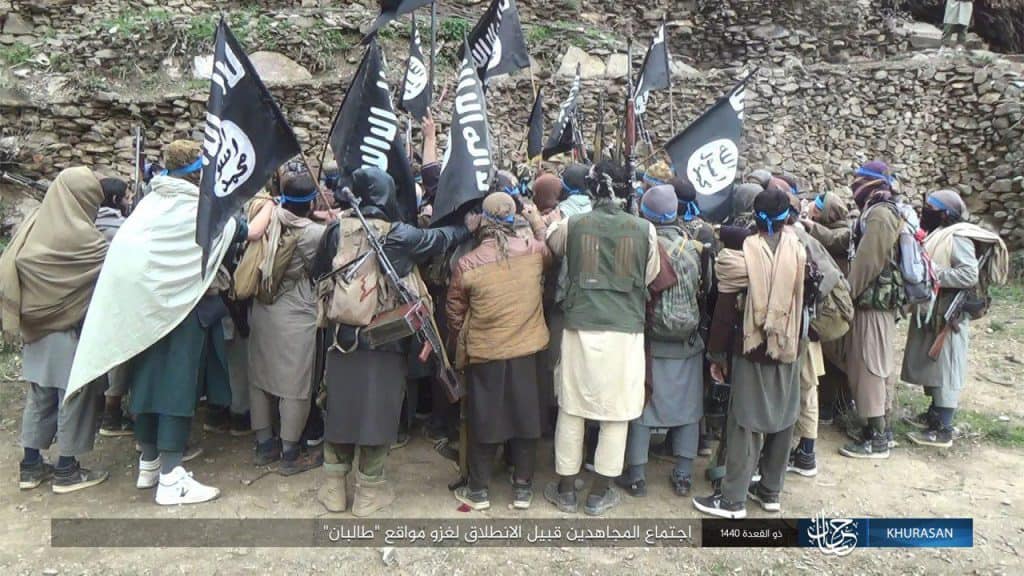
The Islamic State’s central leadership replaced their top man in Afghanistan after a meeting earlier this year, according to a recent report submitted to the United Nations Security Council. The report was authored by the monitoring team responsible for tracking al Qaeda, the Islamic State and affiliated groups.
Mawlawi Zia ul-Haq, also known as Abu Omar al-Khorasani, led the Islamic State’s Khorasan province until April. He was then “dismissed and replaced by Mawlawi Abdullah, also known as Mawlawi Aslam Farooqi,” who “was previously in charge of operations in the Khyber Agency. “
The UN monitoring team found that ul-Haq was demoted “due to poor performance in the context” of the group’s “setbacks in Nangarhar in the second half of 2018.”
The report includes this intriguing detail: Mawlawi Abdullah’s “nomination was made during a visit by an ISIL [Islamic State] core delegation, underscoring the direct relationship between ISIL-K [Islamic State – Khorasan] and the ISIL core in Iraq and the Syrian Arab Republic.”
The report doesn’t explain how this detail was learned. If accurate, then it does indeed illustrate how the Islamic State’s senior managers continue to exercise their influence far from Iraq and Syria even after losing their territorial caliphate.
In another report published earlier this year, the same UN monitoring body said that the “local” Islamic State – Khorasan “leadership maintains close contact with the group’s core in the Syrian Arab Republic and Iraq.” The Islamic State coordinates “the publication of propaganda videos” and “[i]mportant personnel appointments are made through the central leadership.”
It appears that Mawlawi Abdullah’s appointment is another example of how the “central leadership” continues to manage this province.
The authors of the new report identify another key figure in the Islamic State’s Khorasan branch as a Tajik national named Sayvaly Shafiev, also known as “Mauaviya,” who leads a “contingent of approximately 200 fighters” from Central Asia.
Shafiev is “currently operating in Nangarhar Province, where he is a member of the ISIL-K leadership body, or shura.” He “seeks to recruit Tajik fighters and to raise funds using online propaganda in the Tajik language.”
The UN Security Council’s monitoring team reports that the Khorasan province has “suffered military setbacks” and the “intensity of its attacks lessened compared with previous periods.” Moreover, the group’s “[a]ttempts to penetrate Paktiya and Logar Provinces in south-eastern Afghanistan were unsuccessful,” as Abu Bakr al-Baghdadi’s representatives remain “concentrated in Nangarhar and Kunar Provinces, with no organized or open presence outside eastern Afghanistan.”
However, Kunar and Nangarhar aren’t the only provinces where the organization operates. The Islamic State’s Khorasan branch clearly maintains a terror network in Kabul, where the jihadists have conducted a series of operations this year. A previous UN report, finished in January, noted the presence of Baghdadi’s loyalists in the eastern provinces of Nuristan and Laghman as well. Last year, the UN monitoring team reported that the Islamic State had a presence throughout the country, including in northern provinces and in the western province of Herat. Indeed, the jihadists have claimed operations elsewhere in Afghanistan including in Herat, this year.
Fighters in western Afghanistan also renewed their allegiance to Baghdadi in a video posted online in June. That same video documented how the group has an organized presence throughout the region, including in Iran, Kashmir, and Pakistan. [See FDD’s Long War Journal report, Fighters throughout the Khorasan renew allegiance to Abu Bakr al-Baghdadi.]
Still, with respect to Afghanistan, the Islamic State’s Khorasan arm is clearly strongest in the eastern part of the country. And it has suffered losses in northern Afghanistan during the course of the previous year.
Despite its setbacks, UN member states estimate that the Islamic State’s Khorasan arm has “between 2,500 and 4,000” men, “including foreign terrorist fighters.” Outside of Iraq and Syria, the only “province” that rivals the Khorasan operation in terms of force strength is in West Africa, which is thought to have a comparable number of members. (As FDD’s Long War Journal has cautioned in the past, however, it is exceedingly difficult to accurately assess the number of jihadists in any given group.)
The UN’s member states also indicated that the group continues “to maintain a robust capability to derive income from the exploitation of local mineral, lumber and talc resources.” In addition, criminal activities such as “extortion” and “kidnapping for ransom” are used to procure funds.
The UN’s member states claim there is one criminal enterprise that the Islamic State “continues to eschew,” namely “involvement in the narcotics business.” Narcotics trafficking is a source of revenue for the Taliban, and it isn’t clear why the Islamic State has purportedly stayed out of this business.
In any event, while there is always ambiguity in assessing the jihadists’ strengths and weaknesses, it is clear that the Islamic State retains a significant foothold in Afghanistan. And the UN Security Council’s monitoring team reports that the Islamic State’s central leadership continues to oversee the Khorasan province’s operations.








2 Comments
Seems much more effective leadership that shown by the Us and its allies.
These guys fire sub par performers, we promote them.
Wonder why they are winning??
I would disregard most of this “UN monitoring body report” and the pronouncements of the “UN member states.” The US Army Special Forces probably has a more accurate picture of ISIS and Al Qaeda in Afghanistan. Further, IMHO this Afghan war has been America’s longest war primarily because of the cowardice and lack of the political will by US political leaders to inflict overwhelming firepower and economic devastation onto these terror groups and their supporting infrastructure to destroy their will to fight. All this blather about negotiating, sit downs, and compromise are considered by ISIS & Al Qaeda as signs of weakness and encourages them to keep fighting.